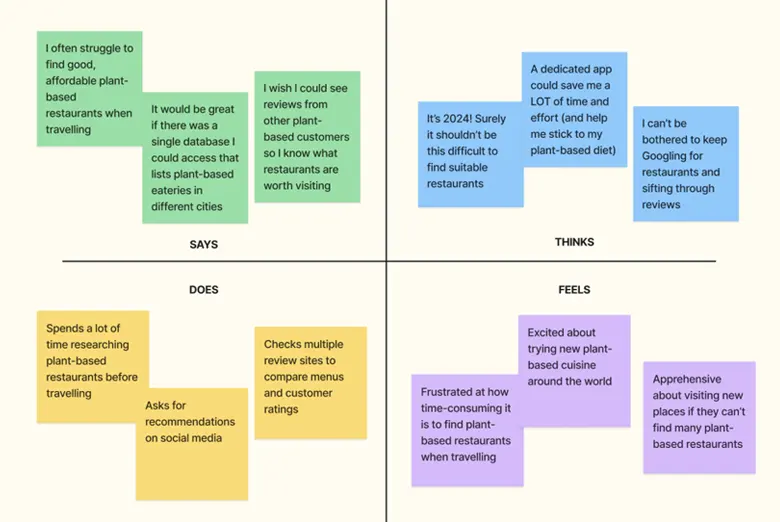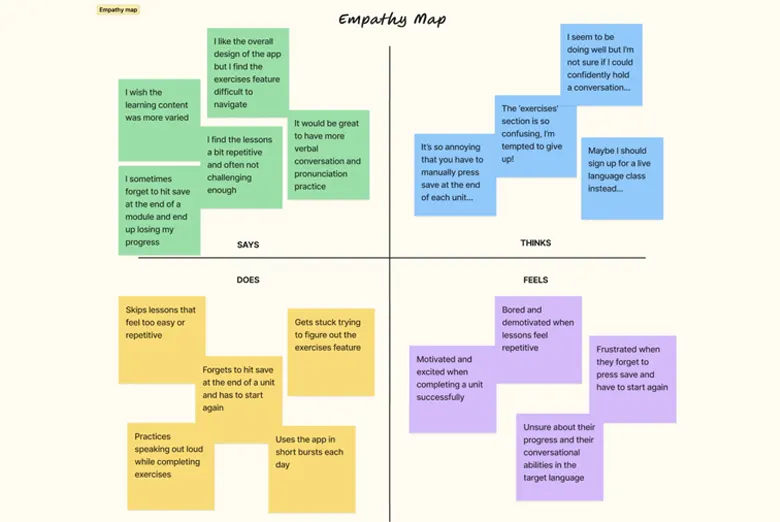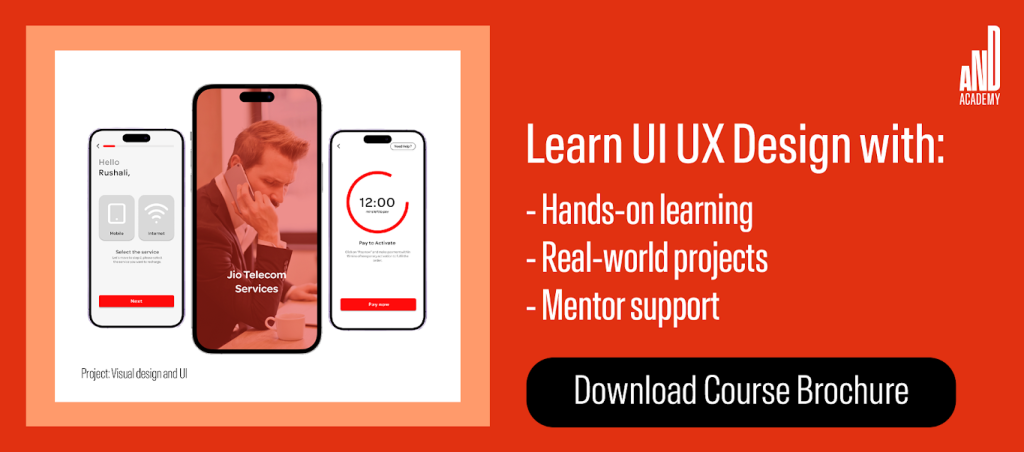Empathy maps help you to channel the end-user’s perspective and design with their needs, goals, and pain points in mind. Learn all about empathy mapping in this practical guide.
You can’t design great products if you don’t truly know your audience. That’s why so much of the UX process is dedicated to uncovering user pain points, defining the problems they need you to solve, and figuring out what they want and need from the solution.
Empathy is at the heart of it all—but putting your own assumptions aside and stepping into someone else’s proverbial shoes can be tricky.
This is where empathy maps come in useful. They focus on what the user says, thinks, feels, and does within a given context, allowing you to channel the user’s perspective and prioritize their needs when making design decisions.
If you’re new to empathy mapping, you’ll find everything you need to know in this guide. We’ll cover:
- What is an empathy map?
- What are the benefits of empathy mapping?
- When to use empathy maps
- How to create an empathy map (step-by-step guide)
- What next? Using your empathy map to inform design decisions
- Understanding the limitations of empathy maps
- Empathy map templates and tools
- Key takeaways and further reading
- Empathy map FAQs
What is an empathy map?
If you’re familiar with the fundamental principles of UX design, you’ll know that the user comes first, always. Empathy mapping helps you to apply this principle and make sure you’re designing with the end user in mind.
An empathy map in design thinking is a simple visualization that captures key insights about your target users. It’s essentially a page divided into four quadrants labeled “Says”, “Thinks”, “Does”, and “Feels”.
Based on what you learn about your audience through user research, you fill in each quadrant of your empathy map to document the user’s perspective.
In doing so, you’re able to empathize with your users and gain a better understanding of what they need in relation to your product.
To illustrate the concept of empathy mapping, here’s an example of an empathy map. We’ve filled it out based on the hypothetical scenario of creating an app to help travelers find plant-based restaurants.

That’s empathy mapping in a nutshell. Next, let’s explore why empathy maps are so useful in the UX design process.
What are the benefits of empathy mapping?
Empathy maps help you to understand your audience
As the name suggests, the greatest benefit of empathy maps is that they help you to empathize with your users.
By the very process of documenting your users’ thoughts, feelings, and actions, you’re stepping into their shoes and considering things from their perspective. This is a crucial step towards understanding your users’ requirements, goals, and pain points—and ultimately designing products that they both need and enjoy.
Empathy maps foster team-wide alignment
Beyond that, empathy maps are an excellent communication tool. They provide a concise, digestible visualization of your most important research insights, enabling you to easily share your findings with the rest of the team (including non-design stakeholders). This helps to foster empathy and a user-centric mindset across the board—which, again, is essential for creating successful products.
Empathy maps may highlight gaps in your research
Empathy mapping also helps to identify gaps in your knowledge and highlight the need for further research. If you’re struggling to fill in the quadrants of your empathy map, you probably need to return to the research phase and gather richer insights into your audience.
Empathy maps lay the foundation for a user-centric design process
Once they’re complete, empathy maps will prove useful throughout the design process. They’re a great precursor to more advanced deliverables such as user personas and customer journeys. And, as you go on to ideate solutions and develop design concepts, your empathy maps will remind you to channel the user’s perspective at all times.
This simple UX tool packs a whole lot of value—and, as long as you’ve got sufficient research data to hand, empathy maps are relatively quick and straightforward to create.
When to use empathy maps
The best time to create an empathy map is in the early stages of the design process, directly or shortly after you’ve conducted user research. If you’re following the design thinking framework, empathy mapping will usually take place in the ‘Empathize’ phase.
Let’s say you’re tasked with improving the design of a language-learning app. You want to understand how your users feel about the app in its current form and pinpoint areas for improvement.
As part of your research, you conduct a series of usability tests where you observe your users as they interact with the app and complete certain tasks. You then follow this up with user interviews.
Based on what your users have told you and what you’ve observed, you organize your insights within the four quadrants of your empathy map. This paints a concise yet holistic picture of your overall research findings.
Here’s an example of how your empathy map might take shape:

As for when to use empathy maps, you can refer back to them at any point throughout the design process. They serve as a great reminder of who your target users are and what they need from your product, helping to steer your design decisions in the right direction.
It’s also important to note that you can revisit and update your empathy maps at any time. You should be learning about your users and building empathy on a continuous basis—and, as your understanding of your audience evolves, so too should your empathy maps.
How to create an empathy map: Step-by-step guide
1. Synthesize your user research data
To create effective and accurate empathy maps, you need a good body of data collected through user research.
Assuming you’ve already conducted user research, the first step is to synthesize your findings and bring some structure to the data.
If you’ve got interview transcripts, you might conduct a thematic analysis—highlighting interesting quotes and organizing your transcripts into distinct themes. If you’ve got notes from observing usability tests, you might divide them into categories such as ‘Pain-points’ and ‘Highlights’.
This lays the necessary groundwork for filling out your empathy map with relevant quotes and insights.

2. Create your empathy map outline (or choose a template)
Now you’re going to create your empathy map outline. You can do this on a blank piece of paper or a whiteboard, in a simple Google Doc, or using a virtual canvas such as Miro, Mural, or Figma.
Whether you’re creating a physical or digital empathy map, simply divide the page into four quadrants and label each quadrant as follows: Says, Thinks, Does, and Feels.
Alternatively, you can use a ready-made empathy map template. If that’s your preferred route, check out our recommendations for empathy map templates and tools in section seven of this article.
3. Fill in each quadrant
With your empathy map template at the ready, you can get to work adding those essential user insights.
You might do this collaboratively in a workshop, inviting stakeholders to add their own sticky notes to each quadrant. Or you can complete this as a solo exercise and share it with your team later for review.
Here are some tips to help you complete each quadrant:
- Says: Try to fill this section with actual quotes from users captured during research. If you don’t have direct quotes, try to come up with realistic examples based on what you know about your target group.
- Thinks: Aim to envision and articulate what’s going through your users’ minds as they contemplate the problem space or interact with your product. This quadrant can cover everything from motivations and aspirations to concerns, assumptions, fears, and frustrations.
- Does: Focus this quadrant on specific actions the user takes, as well as habits and behaviors they exhibit. If you’ve conducted usability tests, this is where you’ll document your key observations.
- Feels: Use this quadrant to describe the users’ emotions as they contemplate the problem space or engage with the product. Include both positive and negative emotions to capture all aspects of the user experience.
4. Review and refine
Once your empathy map is complete, it’s important to review it with a critical eye. Cross-reference each quadrant against your original research data to make sure that your empathy map paints an accurate picture.
At the same time, share your empathy map with one or two colleagues to ensure that it’s clear, readable, and provides meaningful insights.
Finally, consider whether or not your empathy map is sufficiently detailed and well-rounded. If you feel that some quadrants are lacking, you may need to go back and conduct further research.
5. Share your empathy map with all key stakeholders
Happy with your empathy map? Now you can share it with key stakeholders and use it to foster a team-wide understanding of your end users’ needs, goals, and pain points.
You might include your empathy map as part of a broader presentation communicating your research findings, or you might simply share the file with your team and encourage them to explore it in their own time.
What next? Using your empathy map to inform design decisions
The main goal of empathy mapping is to gain a deeper understanding of your target users. In turn, this enables you to design products that effectively address their pain points and help them achieve their goals.
As such, you want to make sure that you use your empathy maps to inform design decisions. So, depending on where you’re at in the design process, turn your empathy map into key action points and next steps.
If you’re in the very early stages, your next step might be to create user personas or come up with a clear problem statement. From there, you might use your empathy maps as the focal point for an ideation session to come up with product concepts or new feature ideas.
Or perhaps your empathy maps reveal some gaps in your research, so the next logical course of action is to revisit the research phase and gather more data.
Ultimately, your empathy maps should guide you in your decision-making and keep the end user’s perspective in focus at all times.
Understanding the limitations of empathy maps
Empathy maps are a highly useful tool for consolidating your research data and channeling the user’s perspective.
However, you can’t rely on empathy maps alone when it comes to understanding your target audience and designing successful products. Like most UX tools and techniques, they have their limitations.
Here are some considerations to bear in mind when working with empathy maps.
Empathy maps are static
Empathy maps are static and often lacking in context. They capture how your users think, feel, and behave at a specific moment in time—but they don’t consider how the experience might vary in a different setting or on a different day, for example.
It’s best to think of empathy maps as a snapshot in time rather than the full picture. Your users’ needs and goals will inevitably evolve and change, and a static persona won’t reflect that.
Empathy maps can be overly simplistic and reductive
As with personas, empathy maps can channel the perspective of a particular audience segment, but they can’t speak for every single user. At the same time, it’s important to remember that people are far more nuanced and complex than the four basic categories of an empathy map.
If you rely too heavily on empathy maps, you risk creating solutions that only cater to a specific audience segment—or that don’t accurately address your users’ needs in their complicated entirety.
For a more well-rounded understanding of your target audience, use empathy maps in conjunction with other research methods and tools.
Empathy mapping is susceptible to bias
When creating empathy maps, you’re working with qualitative data. Unlike quantitative data which can be objectively measured, qualitative data is subjective and open to interpretation.
As you synthesize your research data and create empathy maps, you may unconsciously project your own biases onto how you interpret the data and represent your users.
If you’ve got your own beliefs and ideas about how a product should function, for example, you might unintentionally emphasize data that supports those beliefs. This is known as confirmation bias, and it can prevent you from truly recognizing what your users want.
While it’s difficult to remain entirely neutral when observing your users and analyzing qualitative data, being aware of potential biases can help you to create more objective and accurate empathy maps.
Empathy map templates and tools
If you don’t want to create your own empathy map outline, there are plenty of ready-made templates and tools you can use instead. Check out:
- Miro’s library of empathy map templates and examples. We especially like this simple empathy map template by Invoke, and this AI-enhanced empathy map template created by Martin Gleitsmann.
- The Figma community is full of ready-to-use resources and templates, including empathy maps. Try this empathy map template by Lulu Browne for a collaborative empathy mapping session in FigJam (Figma’s virtual whiteboard tool)—or, for a unique twist on the traditional empathy map format, give this empathy map template by UX Chunks a go.
- This straightforward empathy map template by Mural, a virtual platform and whiteboard built for remote, real-time collaboration.
- This customizable empathy map template is available for free via Moqups.
- This empathy map template from Google Drawings—ideal if you’ve already got a Google account and don’t want to sign up for any additional tools.
Key takeaways and further reading
Empathy maps are a useful tool for synthesizing your research data, fostering empathy for your audience, and helping to prioritize the user throughout the design process.
Just keep in mind that empathy maps present a static and somewhat simplistic snapshot of the entire user experience, so don’t rely on them as your only tool for cultivating empathy.
If you’d like to learn more about the UI UX and the design process that goes into the creation of effective, user-friendly products, check out the following guides:
- How Design Thinking Fosters Empathy and Improves Design Outcomes
- Everything You Need to Know About Wireframes
- What Is Information Architecture in UX Design?
We also recommend checking out this comprehensive UI UX Research done by AND learner Jaazbia Khan to understand the various ways in which you can brainstorm your next project.
Empathy map FAQs
i. Who uses empathy maps?
Empathy maps are a valuable tool for anyone who needs to cultivate empathy for a particular target audience. UX designers, user researchers, and marketers all use empathy maps to gain a better understanding of their users and more effectively meet their needs.
ii. What is empathy map v/s persona map?
An empathy map documents what users say, think, feel, and do. A persona (or persona map) is a fictional character that represents a specific user profile. You might create a user persona to represent, say, your millennial users, and then create an empathy map to capture their thoughts, emotions, and behaviors in a given context.
iii. What are the pros and cons of an empathy map?
Empathy maps are great for helping you understand your target audience, communicate research insights in a visual format, and foster end-user empathy across all stakeholders. Some potential cons of an empathy map are that they may be overly simplistic, lacking in crucial context, and susceptible to bias.
10. Next Steps
We hope this comprehensive guide to design thinking has given you a better understanding of this exciting discipline with myriad applications.
If you are interested in learning more about the field of user experience design, where design thinking is applied very heavily, here are some of the resources you might find useful:
- Watch this session by Shiva Viswanathan, Design Head of Ogilvy Pennywise, and Naman Singh, Product Experience Designer at RED.
- Talk to a course advisor to discuss how you can transform your career with one of our courses.
- Pursue our UI UX Design courses – all courses are taught through live, interactive classes by industry experts, and some even offer a Job Guarantee.
- Take advantage of our scholarship and funding options to overcome any financial hurdle on the path of your career transformation.
Note: All information and/or data from external sources is believed to be accurate as of the date of publication.









